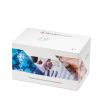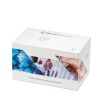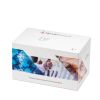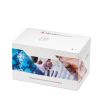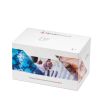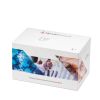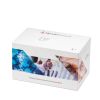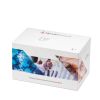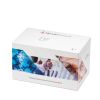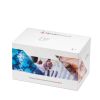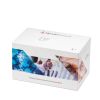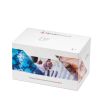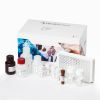Proteinase 3, Human, ELISA kit – 2 x 96 det. - HK384-02
Proteinase 3 (PR3) is a major antigen recognized by autoantibodies directed against cytoplasmic proteins of neutrophilic granulocytes and monocytes (so called anti-neutrophil cytoplasmic autoantibodies (ANCA)).
Quantity
2 x 96 det.
Catalog #
HK384-02
1.359,00 €
Proteinase 3 (PR3) is a major antigen recognized by autoantibodies directed against cytoplasmic proteins of neutrophilic granulocytes and monocytes (so called anti-neutrophil cytoplasmic autoantibodies (ANCA)). ANCA are able to activate primed neutrophils to produce oxygen radicals and release lytic enzymes, including PR3. PR3 was identified as the target antigen of ANCA in Wegener's granulomatosis (WG). ANCA directed against PR3 (PR3-ANCA) can interfere with the binding of PR3 to its physiological inhibitor alpha1-antitrypsin (alpha1-AT) and with the proteolytic activity of PR3. At the site of inflammation PR3 can cleave the complex between these inhibiting ANCA and PR3 itself, leaving active PR3. Autoantibodies to PR3 are potent activators of the 5-lipoxygenase pathway in primed human neutrophils. Extracellular free arachidonic acid, as present at an inflammatory focus, synergizes with such autoantibodies to evoke full-blown lipid mediator generation, granule secretion and respiratory burst.
PR3 is a neutral serine proteinase, which is localized in the azurophilic granules of neutrophils and in granules of monocytes and can be detected in the membrane of secretory vesicles. PR3 degrades a number of extracellular matrix proteins such as elastin and inactivates human C1 inhibitor. Membrane-associated PR3 is also able to activate caspase-3 without triggering apoptosis of neutrophils, which is possibly a neutrophil survival mechanism. In addition, PR3 is involved in myeloid differentiation and is, therefore, also called myeloblastin. PR3 matures/activates major inflammatory cytokines like membrane bound TNF, IL1beta and IL18. It has an important role in inflammasome-independent induction of inflammation and an important role in inflammatory diseases as Reumatoid Arthritis, IBD and inflammatory-associated disease as Type 2 diabetes, cardiovascular diseases and artherosclerosis.
PR3 is a neutral serine proteinase, which is localized in the azurophilic granules of neutrophils and in granules of monocytes and can be detected in the membrane of secretory vesicles. PR3 degrades a number of extracellular matrix proteins such as elastin and inactivates human C1 inhibitor. Membrane-associated PR3 is also able to activate caspase-3 without triggering apoptosis of neutrophils, which is possibly a neutrophil survival mechanism. In addition, PR3 is involved in myeloid differentiation and is, therefore, also called myeloblastin. PR3 matures/activates major inflammatory cytokines like membrane bound TNF, IL1beta and IL18. It has an important role in inflammasome-independent induction of inflammation and an important role in inflammatory diseases as Reumatoid Arthritis, IBD and inflammatory-associated disease as Type 2 diabetes, cardiovascular diseases and artherosclerosis.
| Datasheet URL | https://www.hycultbiotech.com/wp-content/uploads/2022/06/HK384-0717.pdf |
|---|---|
| Quantity | 2x96det. |
| Quantity | 2 x 96 det. |
| Standard range | Measurable concentration range of 0.63 to 40 ng/ml. |
| Detection level | Minimum concentration which can be measured is 0.63 ng/ml. |
| Working volume | 100 µl/well |
| Species | human |
| Cross reactivity | Mouse - No, Pig - No, Rat - No |
| Alias | PR3, PRTN3, Myeloblastin |
| Application | The Human Proteinase 3 ELISA kit is to be used for the in vitro quantitative determination of Proteinase 3 in serum and plasma samples. |
| Principle | The Human Proteinase 3 ELISA is a ready-to-use solid-phase enzyme-linked immunosorbent assay based on the sandwich principle with a working time of 3½ hours. The efficient format of a plate with twelve disposable 8-well strips allows free choice of batch size for the assay. Samples and standards are incubated in microtiter wells coated with antibodies recognizing Human Proteinase 3. Biotinylated tracer antibody will bind to the captured Human Proteinase 3. Streptavidin-peroxidase conjugate will bind to the biotinylated tracer antibody. Streptavidin-peroxidase conjugate will react with the substrate, tetramethylbenzidine (TMB). The enzyme reaction is stopped by the addition of oxalic acid. The absorbance at 450 nm is measured with a spectrophotometer. A standard curve is obtained by plotting the absorbance (linear) versus the corresponding concentrations of the Human Proteinase 3 standards (log). The Human Proteinase 3 concentration of samples, which are run concurrently with the standards, can be determined from the standard curve. |
| Storage and stability | Product should be stored at 4 °C. Under recommended storage conditions, product is stable for at least six months. |
| Precautions | For research use only. Not for use in or on humans or animals or for diagnostics. It is the responsibility of the user to comply with all local/state and Federal rules in the use of this product. Hycult Biotech is not responsible for any patent infringements that might result with the use of or derivation of this product. |
| Disease | Autoimmunity |
| Application assays: | The Human Proteinase 3 ELISA kit is to be used for the in vitro quantitative determination of Proteinase 3 in serum and plasma samples. |
|---|---|
| Principle: | The Human Proteinase 3 ELISA is a ready-to-use solid-phase enzyme-linked immunosorbent assay based on the sandwich principle with a working time of 3½ hours. The efficient format of a plate with twelve disposable 8-well strips allows free choice of batch size for the assay. Samples and standards are incubated in microtiter wells coated with antibodies recognizing Human Proteinase 3. Biotinylated tracer antibody will bind to the captured Human Proteinase 3. Streptavidin-peroxidase conjugate will bind to the biotinylated tracer antibody. Streptavidin-peroxidase conjugate will react with the substrate, tetramethylbenzidine (TMB). The enzyme reaction is stopped by the addition of oxalic acid. The absorbance at 450 nm is measured with a spectrophotometer. A standard curve is obtained by plotting the absorbance (linear) versus the corresponding concentrations of the Human Proteinase 3 standards (log). The Human Proteinase 3 concentration of samples, which are run concurrently with the standards, can be determined from the standard curve. |
| Perfomance: | The linearity of the assay was determined by serially diluting 10 EDTA plasma samples containing human Proteinase 3. The diluted sample was measured in the assay. Samples were diluted at least 5 times. |
| Recovery: | Normal human blood samples (plasma) containing baseline levels of human Proteinase 3, were spiked with human Proteinase 3, in concentrations of 20, 5 and 1.25 ng/ml. Samples with and without human Proteinase 3, were incubated for 1 hour at room temperature. Samples were measured using the ELISA. Values for human Proteinase 3, ranged between 92% and 113%. |



